Adam Yamey's Blog: YAMEY, page 20
March 25, 2025
An artist from India in a park in London
THE SERPENTINE NORTH (Sackler) Gallery (in London’s Hyde Park) is hosting a wonderful exhibition until 27 July 2025. It is displaying paintings and drawings created by Arpita Singh (née Dutta), who was born in Baranagar (now in West Bengal, India) in 1937. Between 1954 and 1959, she studied for a Diploma in Fine Arts at the Delhi Polytechnic in New Delhi. In 1962, she married the artist Paramjit Singh, and they live in New Delhi.
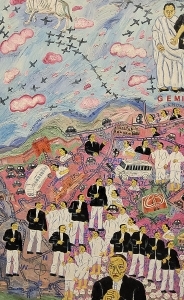
The works on display at the Serpentine were created from 1971 onwards. All of them were both intriguing and enjoyable to see. Even without knowing what the artist intended, I got the feeling that, apart from some abstract works, the images Singh creates are full of messages, stories, symbolism, allusions to feminism, and social comment. Though full of meanings, Singh’s works are subtle – their messages, which are left for the viewer to interpret, are not ‘full on’, but add to the visual enjoyment of the images. Her colourful paintings often lack the conventional European way of depicting perspective. In many of the paintings and drawings, the elements of the composition seem to be floating on the canvas or paper. Some of the pictures look like collages, but on closer examination what appeared to have been stuck on was in fact painted on the artwork.
The colourful artworks on display at the Serpentine are well worth seeing. It is a special show not only because it is her first solo exhibition outside India but also because Singh’s work is so satisfying to see.
March 24, 2025
At Kew Gardens
March 23, 2025
Painted in blue and displayed at Kew
THE SHIRLEY SHERWOOD Gallery of Botanical Art is a relatively new addition to the buildings dotted around London’s Kew Gardens. It is an attractive clean lined contemporary edifice containing several interconnected exhibition spaces of varying sizes. Until 23 March 2025, it is housing an exhibition of mostly enormous ceramic objects, which were created by Felicity Aylieef, Professor of ceramics and glass and research at the Royal College of Art, London.
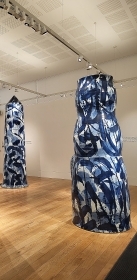
The enormous ceramic objects, which look like grossly magnified jars and vases, were handmade by craftsmen in China, whose names were not prominently displayed (if at all) in the exhibition. Ms Aylieff has painted attractive designs on the vessels using blue paint containing cobalt oxide. The painted ceramic objects are then placed back into enormous kilns, and fired once again to fix the painted designs and to glaze them. Undoubtedly, what she creates is impressive, but maybe pointless. However, the art historian John-Paul clarifies things a bit:
“These are objects to be encountered physically, peered at anear, admired from afar. They may derive from utilitarian vessels, but as objects they are architectural, sculptural even, in their forms. Painterly, we might also say, for the manner in which their surfaces are articulated with glazes”. (Quoted from a label at the show).
I enjoyed seeing these gigantic ceramic objects, but kept wondering whether the great effort (especially physical) to make them was worthwhile.
March 22, 2025
They say lightning never strikes the same place twice
THE ONLY PERSON I know who has been struck by lightning and lived to tell the tale was one of my fellow dental students at University College Hospital Dental School. He was a keen golfer, as many dentists are, and was hit while out on the golf course.
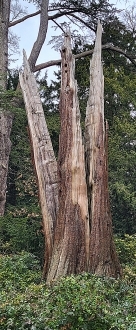
Years after that, I was told a joke that concerns lightning. It goes like this. The businessman and the bishop were out on the golf course. The businessman made a lousy shot, and said:
“Jesus, I missed.”
The bishop said:
“You should not take the Lord’s name in vain.”
Then, there was a rumble of thunder, and the bishop was struck dead by lightning. A voice boomed out from the heavens above:
“Oh blast, I missed.”
Now, to get to the point of this essay. A few days ago (in March 2025), we visited the wonderful gardens at Anglesey Abbey in Cambridgeshire. In it there are plenty of trees, but one of them, a redwood, is particularly interesting. All the remains of the tree is part of its tall trunk, and that is not intact: it has dramatic longitudinal splits. This is because it was struck by lightning. However, it was not struck once, but twice (in 1987 and then again in 1999). So much for the old saying: ‘lightning never strikes the same place twice’.
March 21, 2025
A hamlet with a memorable name in Cambridgeshire
ONE OF MY FAVOURITE uncles used to be highly amused by the name of a place found on maps of eastern England. The place is Six Mile Bottom. The first time I heard him mention the place was when I was about six years old. As far as I can recall, I never visited the place until today (17 March 2025). As we were passing near it, we took a small detour to see it. There is not much to see, but at least I have at last been there.
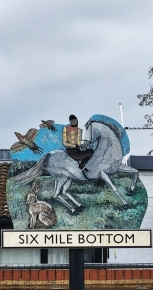
Six Mile Bottom is a hamlet in the Cambridgeshire parish of Little Wilbraham, which is not far from Cambridge. The place was so named in 1801 because it is six miles from Newmarket and rests in a ‘bottom’ (an old name for a valley).
Before the 1790s, there was only one building in the place. In 1802, a large dwelling was built close by. One of its earliest residents was Augusta Leigh, who was a half-sister of the celebrated Lord Byron. Otherwise, Six Mile Bottom cannot boast of any other noteworthy former or current residents. There was a railway station at the hamlet, which served passengers between the 1860s and 1967. The hamlet still has a single-track railway running past it and boasts of two level-crossings.
During our brief visit to Six Mile Bottom, we parked outside the only shop, the Six Mile Bottom Spar grocery store. Across the road from it, there a carved stone cross, which serves as a war memorial. This monument records the names of the 16 men from Six Mile Bottom, who died during WW1. A side road leads across one of the hamlet’s level crossings to the Church of St George, which is constructed in brick and flint. Its foundation stone was laid in 1933, and the edifice was built by 1935. Mrs Favell Helen Hall, who laid the stone, was the widow of Major Alexander Cross Hall (1869-1920), who served in both the Second Anglo-Boer War and WW1 (www.iwm.org.uk/memorials/item/memorial/82010). The Major’s father, William Henry (Bullock) Hall (1837-1904), was the first-class cricketer and military historian, who changed his surname from Bullock to Hall when he inherited two Cambridgeshire estates from his uncle General John Hall of Weston Colville and Six Mile Bottom. The major lived and died at Great Rollright in Oxfordshire. Our brief visit to Six Mile Bottom today has satisfied my curiosity about the place whose name used to amuse my uncle. I am not sure that I would bother making a detour to see this hamlet too often. Maybe, once is enough.
March 20, 2025
Seeing things from a different perspective at South Kensington
AN EXHIBITION AT LONDON’S Victoria and Albert Museum, which is showing until 5 May 2025, displays works of art created in the Moghul Empire between about 1560 and 1660, a period in which the Emperors Akbar, Jahangir and Shah Jahan reigned. Apart from wonderful jewels, jewellery, jewel-encrusted swords, and various other luxurious items, the exhibition contains a superb array of painted miniatures. Each one of these meticulously painted images is filled with a wealth of detail, and depict people as well as scenes of (often) courtly life.
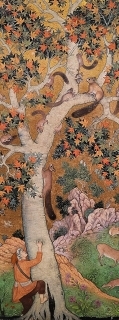
The miniature paintings differ from those created in Western Europe (notably in Italy, France, Germany, and the Low Countries) during that period in many ways. One of these differences is the portrayal of perspective. To the eyes of people used to looking at Western European paintings of the late sixteenth and early seventeenth centuries, the Mughal miniatures seem to lack any obvious portrayal of perspective when compared to what was being painted at the same time in Western Europe.
Many of us living in the twenty-first century are accustomed to seeing perspective portrayed in the way it has been done since the fifteenth century, when it was pioneered by the architect and engineer Filippo Brunelleschi, who rediscovered what the Ancient Greeks and Romans knew already. While I was looking at the Mughal miniatures, I wondered whether people who were living in the Mughal Empire at the time when they were painted saw the images in a different way to us, who are used to having perspective ‘spelled out’ or depicted in the Western European way. Did they look at the paintings and understand the perspective, without it having to be emphasised as it is in European art? Did their experience of life, as it was, allow them to understand the spatial relationships of the subject matter depicted in the paintings, or would it have seemed to lack depth as it does when we look at it today? Or was the subject matter more important to them than how it looked in ‘real life’?
March 19, 2025
A lady from England who saved a nation in the Balkans
MARY EDITH DURHAM (1863-1944), usually known as ‘Edith Durham’, who is well-known to many Albanians but little-known amongst British people, was a remarkable woman. Trained at Bedford College and the Royal College of Art, she was an accomplished artist, a prolific writer, a skilled anthropologist, and a formidable political lobbyist. On the evening of 14 March 2025, the Embassy of Kosovo in London hosted an event to celebrate the life and achievements of this lady, whose work was of great importance in the Balkans, especially in what is now Albania and Kosovo. It was organised by the Anglo Albanian Association led by its Chairman Stephen Nash and members of the association’s committee. Several speakers gave interesting talks about different aspects of Edith’s life. Between the speakers, the actress and presenter Joanna Lumley read short excerpts from some of the books written by Edith Durham.
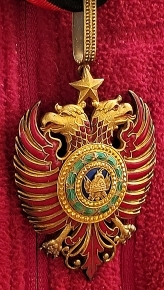
In 1900, Edith’s medical advisor suggested that for the good of her health, she should take a break from her busy life in England. She travelled to Montenegro, and thus began her many years of arduous travelling around the Western Balkans, learning about the people who lived there, their traditions and ways of life, their problems, and the complex political situation in the region. The Oxford historian Noel Malcolm was the first speaker. Briefly and succinctly, he gave a comprehensive outline of the complex political situation prevailing in the Balkans when Edith worked there. In a nutshell, the region was the epicentre of the struggle to determine how the Balkan territory was to be divided up as the Ottoman Empire was suffering its death throes. The translator (of Albanian novels including those of Ismail Kadare, who died in 2024) John Hodgson gave a fascinating talk about his first visits to Kosovo in the early 1980s when many country people were still living the way that they were when Edith Durham visited them before WW1, and then wrote about them in her books.
James Hickson, who is the grand nephew of Edith Durham, gave a fascinating talk about Edith’s family: her parents and her eight siblings, many of whom, like Edith, went on to do remarkable things. Edith was the oldest child, and after her father died, she was left to care for some of the family as well as continuing her work as a successful artist. It was the stress of this overworking that caused her to become so unwell that her doctor recommended she took the holiday, which led to her involvement with the Balkans and the Albanian people, in particular. Wherever she travelled in the Balkans, Edith was welcomed by local people. While staying with them, she observed their customs and all aspects of their daily lives. She was given and purchased many items (clothing, domestic tools, fabrics, and much more), which she brought back to England. Many of these precious mementoes of her trips are housed in two museums: one in the Bankfield Museum in Halifax (Yorkshire), and the other, the Horniman Museum in Forest Hill (London). Rachel Terry of the Bankfield and Peronel Craddock of the Horniman both spoke, and explained how their museums obtained the exhibits collected by Edith Durham, and what items their collections house. Hearing them has made me want to revisit the Horniman, and to pay a first visit to the Bankfield.
Elizabeth Gowing, who has written a very personal account of her ‘discovery’ of Edith Durham after she first visited Kosovo in 2006, also spoke (via a Zoom link from Prishtina) briefly about Edith and how she came across this extraordinary woman. Another speaker was David Oakley-Hill, whose father Dayrell R. Oakley-Hill (1898-1985) played a leading role in running the Gendarmerie of Albania during the reign of King Zog. He lived and worked in the country between 1929 and 1938. His son related that his father and Edith Durham communicated with each other. David is currently completing a book about another formidable English woman, who worked in Albania: Margaret Hasluck (1885-1948). Edith and Margaret wrote letters to each other, and David will be including some of them in his forthcoming book.
I wrote earlier that Edith is far from well-known in Britain. Brian Ferris, another speaker, is valiantly trying to remedy this situation by attempting to get a commemorative plaque attached to a house where Edith lived in London (36 Glenloch Road in Belsize Park). He related the frustrating difficulties that he is facing in trying to achieve this. I have discovered that she also lived, albeit briefly, at two other addresses around Belsize Park (see: https://historywiki.therai.org.uk/index.php?title=Mary_Edith_Durham).
Joanna Lumley read extracts from some of Edith’s books in between the various speakers’ presentations. Most of them came from “High Albania” (first published in 1909), which is, so far, one of the best books that has been written about Albania in English. Before reading the first extract of the evening, she explained that after her first brief visit to Albania, she fell in love with the country. With her readings and the excellent presentations by the various speakers, all introduced by Stephen Nash, the event hosted by His Excellency the Ambassador of Kosova, Ilir Kapiti, was both enjoyable and highly informative. It was a fine appreciation of the woman whose empathy with the Albanians, observations, and political lobbying saved what is now the country of Albania from being carved up by the countries around it and becoming incorporated into them.
March 18, 2025
An artist from South Africa and a civil war
DURING THE ANGOLAN civil war (1975-2002), many Angolan families were forced to flee to South Africa. The parents of Helena Uambembe, who was born in South Africa in 1994, were amongst those who were forced to leave Angola. Her father was coerced to join the South African Defence Force (‘SADF’), which was engaged in fighting in southern Angola during the period when the Apartheid regime was still in power. He was enrolled in the 32 Battalion of the SADF.
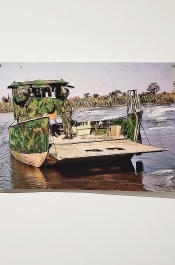
Until 20 March 2025, there is an exhibition of art works by Ms Uambembe at the Goodman Gallery in Mayfair’s Cork Street. Her intriguing and somewhat terrifying works are on paper, canvas, and cloth. The drawings on display show her interest in the kind of posters used to attract young people into joining the military. I felt that these pictures illustrated the fearsome nature of serving in the military, rather than its attractions. A large cloth work with images printed on it depicts the loss of self-identity or individuality that members of the military must undergo.
The small exhibition is visually exciting, of interest historically, full of angst about the war in Angola and now elsewhere, and well worth visiting.
March 17, 2025
AN artist born in Egypt who makes sculptures in Switzerland
THE WADDINGTON CUSTOT Gallery in Mayfair’s Cork Street puts on excellent exhibitions and the current show, which goes on until 10 April 2025, is no exception. It is an exhibition of sculptures by Yves Dana, who was born in Alexandria (Egypt) in 1959. He moved with his family to Switzerland in 1961. It is there that he lives and works. In the early 1980s, he set up a sculpture studio in Lausanne (Switzerland). In 1996, he paid a return visit to Egypt. Following that, his approach to sculpture changed dramatically. The sculptures on display at Waddington Custot were made long after that visit to the land of his birth; they date from 2004 until 2024.
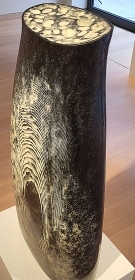
Each of the works we saw, both at the gallery and outdoors in Smithson Plaza (near Bury Street), is pleasing to the eye. Many of the sculptures allude to the art of Ancient Egypt in subtle ways. Several of the artworks brought to mind the simple beauty of Cycladic sculptures and others evoke the harshness of desert climates. The gallery’s website revealed that Dana:
“… sources the best quality stone from around the world, including limestone from Egypt, France and Turkey, serpentine from Italy and diabase from Germany. He combines innovative carving techniques with traditional tools to create precise planar forms. With each work created over several weeks or months, the physicality of carving stone, with deep sensitivity to its tones and texture, is evident in the subtlest details of each work.”
This is very evident as one looks at the often sensuously shaped abstract forms of his sculptures. Where there is an interesting detail inherent in the material, he shapes the sculpture so that the viewer’s eyes are drawn to it. Although Dana imposes his artistic will on the materials he employs, he is also sympathetic to their original forms and textures and does not force them to submit totally to his compositional ideas. `Put another way, it seems that Dana’s compositions are guided by the physical properties and shape of the materials he is using.
As you can gather from what I have written, brief though it is, I enjoyed seeing this show and getting to know the work of an artist, whom I had not known about before.
March 16, 2025
An artist from a remote island north of Australia
THE TIWI ISLANDS, consisting of Bathurst Island and its larger neighbour Melville Island, can be found out at sea about 37 miles north of the northern Australian city of Darwin. According to the 2021 census, the Tiwi Islands have a population of about 2,350, most of whom are aboriginal Tiwi people. One of these people, who lives and works on Melville Island, is the artist Jonathon World Peace Bush. Currently, there is an exhibition of his paintings at Frieze No. 9 Cork Street (in London’s Mayfair), which ends on 15 March 2025.
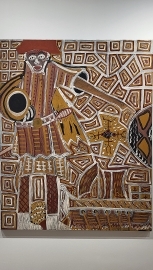
Bush’s paintings are vividly coloured using the three natural pigment colours typical of Tiwi art: white, yellow, and red. At first sight, the paintings have an almost naïve appearance. But this is misleading. Bush shows the influence of great western artists (such as Francis Bacon and Velasquez) and at the same time manages to capture the spirit of Tiwi art. The resulting works are vibrant and exotic but at the same time have a familiarity about them. This is because the artist has chosen to depict famous historical figures such as St Joan of Arc, Queen Victoria, Pope Francis, and Christopher Columbus. These people are recognisable in Bush’s paintings, but are set against a background of traditional Tiwi decorative features. According to a leaflet available at the exhibition, Bush shows in his paintings the tension between western colonial culture and traditional Tiwi beliefs. He does this in an often-witty style. It was interesting to see an exhibition of works by an artist who combines the indigenous art of his home with what he has discovered about the nature of Western European art. Furthermore, I am sure that, like me, most people reading this will not have heard of the Tiwi Islands. I am very pleased that (quite by chance) we stumbled on this fascinating exhibition while visiting a less interesting show in the same building.




